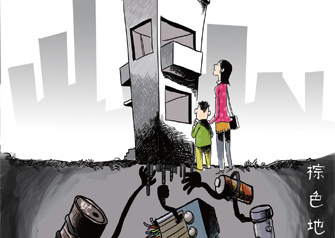(Ecns.cn)--Though he bought a new house in Wuhan, the capital of Hubei province, over a year ago, Zheng Hongyuan's family continues to live in a rented house located elsewhere. Like many other frustrated people who bought property in the area, Zheng lives in fear of what lurks in the ground below it.
In October 2010, Zheng got the keys to his new house in an affordable housing project. But just as he had finished sprucing up the place and was about to move in, Zheng received news on November 30 that destroyed his dreams.
Zheng learned that the new house was located on a "brownfield site," which means that the land had previously been used for industrial or commercial purposes that had very likely left the area contaminated by hazardous waste or pollution.
Zheng discovered that the plot of land had been subjected to contamination for over 60 years, first by a pharmaceutical factory and later a chemical plant.
In 1997, after the chemical plant closed, a factory for manufacturing electroplating additives moved in, exposing the land to further pollution, which included numerous fluorine products.
In March 2009, an environmental study by the China University of Geosciences (CUG) showed that the land released poison gas inherited from the factories that had operated there, making it a typical brownfield site.
"Living in houses built on such land can affect human health in many ways. Throughout history, we have seen tragedies caused by brownfield sites," said Gao Shengda, chief editor of an environmentally-focused Web site. The Love Canal crisis in the U.S. that began in the spring of 1978 revealed how badly chemical waste can influence people's health, he added.
Zheng is not the only homeowner who has chosen not to live at the site in Wuhan. Out of more than 2,400 apartments, about 60 percent are economically affordable housing. Many of the current owners spent almost all of their savings to buy the houses, but are now faced with a very grim outlook.
After seeing the CUG research, the Wuhan Environmental Protection Bureau (WEPB) announced that the plot was not suitable for housing. It was too late, however, as construction had already begun. In order to address the issue, the bureau asked the real estate developer to lay down a cover layer of safe soil and increase greening in the area.
Though the tract of land passed environmental testing by the local government in September 2010, people who own housing there do not believe it is safe for their children or themselves. Nevertheless, calls for justice and refusals to move in have produced no results.
On December 2, 2010, the WEPB gave a press conference where officials announced that they would take no further action to help manage the land. "We have spent a lot to build economically affordable housing here, and we do not think it is worth it to spend more to manage it," said a spokesman.
Brownfield sites in Wuhan are not a rare phenomenon, nor are they uncommon in Guangzhou and Beijing, where there have also been reports of polluted land being used for economically affordable housing. Some may think that the government only sells contaminated property to poor people, but others say it is only be the tip of the iceberg.
Around 1990, many polluting factories were forced to move away from city centers, leaving large areas of land for real estate developers to bid on. By 2008, contaminated land used to build housing in Beijing, Jiangsu, Liaoning, Guangdong, Chongqing and Zhejiang amounted to over 20,000 hectares, equal to over 28,000 football fields, according to research by the Chinese Academy of Sciences.
As polluting factories move to other places, many are not properly cleaned up before real estate developers rush in to build new houses and sell them to people from all walks of life – both rich and poor.
The central government claims to have investigated contaminated land used for housing construction in China since 2006, but till now no report has been published.


















